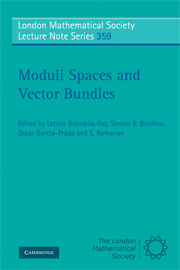Book contents
- Frontmatter
- Contents
- Preface
- Acknowledgments
- Part I Lecture Notes
- 1 Lectures on Principal Bundles
- 2 Brill-Noether Theory for Stable Vector Bundles
- 3 Introduction to Fourier-Mukai and Nahm Transforms with an Application to Coherent Systems on Elliptic Curves
- 4 Geometric Invariant Theory
- 5 Deformation Theory for Vector Bundles
- 6 The Theory of Vector Bundles on Algebraic Curves with Some Applications
- Part II Survey Articles
- Part III Research Articles
4 - Geometric Invariant Theory
Published online by Cambridge University Press: 07 September 2011
- Frontmatter
- Contents
- Preface
- Acknowledgments
- Part I Lecture Notes
- 1 Lectures on Principal Bundles
- 2 Brill-Noether Theory for Stable Vector Bundles
- 3 Introduction to Fourier-Mukai and Nahm Transforms with an Application to Coherent Systems on Elliptic Curves
- 4 Geometric Invariant Theory
- 5 Deformation Theory for Vector Bundles
- 6 The Theory of Vector Bundles on Algebraic Curves with Some Applications
- Part II Survey Articles
- Part III Research Articles
Summary
These notes are based on lectures given at the CIMAT College on Vector Bundles and describe a method of constructing quotients in algebraic geometry. Geometric Invariant Theory (GIT) is due originally to Mumford [GIT], but some of the ideas go back to 19th century invariant theory, especially the work of Hilbert in the 1890s. The lecture notes are essentially unchanged from those given out when the lectures were given and are intended to be reasonably self-contained, although some proofs are omitted; further details, if needed, can be found in [Tata]. I have added an appendix describing the application of GIT to moduli problems and particularly to the construction of moduli spaces for vector bundles on algebraic curves; this material is adapted from my “Polish” notes [Pol].
The natural context for the construction is that of schemes, but for simplicity (except to a limited extent in the appendix) we work always with varieties defined over an algebraically closed field k; this field can have any characteristic. All topological terms refer to the Zariski topology.
The references are divided into two sections. The first lists works directly connected with the material described in the lectures and served as the reference list for those lectures. The second lists some other key works; it is not by any means a comprehensive list.
For the construction of quotients, we make the standard assumption that the group G is reductive.
- Type
- Chapter
- Information
- Moduli Spaces and Vector Bundles , pp. 99 - 127Publisher: Cambridge University PressPrint publication year: 2009
- 7
- Cited by

